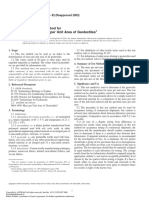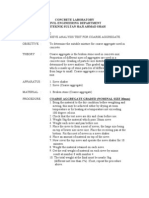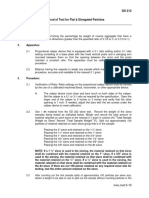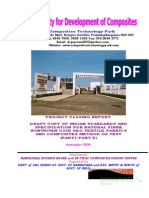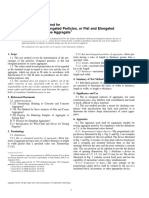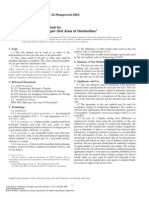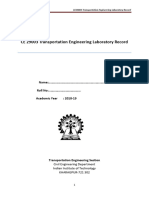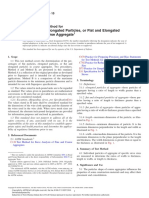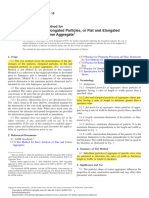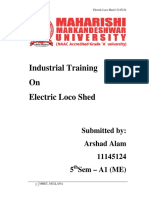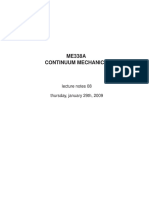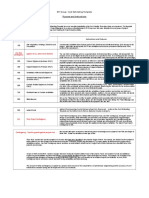Determining Flat and Elongated Particles: Test Procedure For
Determining Flat and Elongated Particles: Test Procedure For
Uploaded by
Shan AvisadoCopyright:
Available Formats
Determining Flat and Elongated Particles: Test Procedure For
Determining Flat and Elongated Particles: Test Procedure For
Uploaded by
Shan AvisadoOriginal Description:
Original Title
Copyright
Available Formats
Share this document
Did you find this document useful?
Is this content inappropriate?
Copyright:
Available Formats
Determining Flat and Elongated Particles: Test Procedure For
Determining Flat and Elongated Particles: Test Procedure For
Uploaded by
Shan AvisadoCopyright:
Available Formats
DETERMINING FLAT AND ELONGATED PARTICLES TXDOT DESIGNATION: TEX-280-F
Test Procedure for
DETERMINING FLAT AND ELONGATED PARTICLES
TxDOT Designation: Tex-280-F
Effective Date: February 2005
1. SCOPE
1.1 Use this test method to determine the percentage of flat and elongated particles in coarse
aggregates. Flat and elongated aggregate particles interfere with compaction and can
result in harsh, difficult to place materials. They also break under load and prevent
development of an adequate aggregate skeleton.
1.2 The values given in parentheses (if provided) are not standard and may not be exact
mathematical conversions. Use each system of units separately. Combining values from
the two systems may result in nonconformance with the standard.
2. DEFINITIONS
2.1 Flat and Elongated Particles—aggregate particles having a ratio of length to thickness
(L/T) greater than a specified value.
2.2 Length (L)—maximum dimension of the particle.
2.3 Width (W)—maximum dimension in the plane perpendicular to the length.
2.4 Thickness (T)—maximum dimension perpendicular to the length and width.
3. APPARATUS
3.1 Proportional caliper device, consisting of a base plate with two fixed vertical posts and a
swinging arm mounted between them so that the openings between the arms and the posts
maintain a constant ratio.
3.1.1 Adjustable axis position to provide the desired ratio of opening dimensions for the ratios
of 1:2, 1:3, 1:4, and 1:5. Verify the ratio settings on the proportional caliper device using
a machined block, micrometer, or other appropriate device.
3.2 Balance, Class G2 in accordance with Tex-901-K, minimum capacity of 2000 g.
4. SAMPLING
4.1 Sample a representative amount of coarse aggregate in accordance with Tex-221-F.
CONSTRUCTION DIVISION 1–3 LAST REVIEWED: SEPTEMBER 2014
DETERMINING FLAT AND ELONGATED PARTICLES TXDOT DESIGNATION: TEX-280-F
4.2 Reduce the sample to an amount suitable for testing in accordance with Tex-200-F.
5. PROCEDURE
5.1 Oven-dry the sample to constant weight, at a temperature of 230 ± 9°F (110 ± 5°C). Dry
the limestone rock asphalt to constant weight at a temperature of 140 ± 5°F (60 ± 3°C).
5.2 Sieve the sample in accordance with Tex-200-F, Part I, using a 7/8 in., 5/8 in., 1/2 in.,
3/8 in., and a No.4 sieve.
5.3 Reduce each size fraction with 10% or more retained by quartering in accordance with
Tex-200-F, until obtaining approximately 100 particles for each size.
5.4 Test each of the particles in each size fraction as follows:
5.4.1 Set the proportional caliper device to the proper ratio (e.g., 5:1).
5.4.2 Set the larger opening equal to the particle length. The particle is flat and elongated if the
maximum dimension perpendicular to the length and width (thickness) can be placed
through the smaller opening.
5.5 Place the tested particles into one of two groups:
flat and elongated or
not flat and elongated.
5.6 After classifying the particles into one of the groups described in Section 5.5, count and
record the number of particles in each group.
5.6.1 Divide the total number of flat and elongated particles by the total number of particles
tested.
5.6.2 Multiply by 100 and record to the nearest 0.1 percentage point.
6. CALCULATIONS
6.1 Using the sieve analysis determined in Section 5.2, add the percentages of the sieve sizes
with 10% or more retained to determine an accumulative weighted total based on the
sample tested. Divide the individual percentage of each sieve size by the accumulative
weighted total. This is the adjusted sieve analysis of the sample tested for flat and
elongated particles. See Table 1.
6.2 Calculate the percentage of flat and elongated particles for each sieve size as described in
Section 5.6.
6.3 Multiply the adjusted sieve percentage by the corresponding percentage of flat and
elongated particles for each sieve size and for each ratio tested (e.g., 5:1). Divide this
number by 100. See Table 1.
CONSTRUCTION DIVISION 2–3 LAST REVIEWED: SEPTEMBER 2014
DETERMINING FLAT AND ELONGATED PARTICLES TXDOT DESIGNATION: TEX-280-F
Table 1—Calculation Example
Sieve % % % % adjusted %
7/8 in. 4.8
5/8 in. 17.8 17.8 17.8 ÷ 88.5 = 20.1
1/2 in. 42.1 42.1 42.1 ÷ 88.5 = 47.6
3/8 in. 28.6 28.6 28.6 ÷ 88.5 = 32.3
No. 4 6.7 0.0 0.0 ÷ 88.5 = 0.0
88.5 100.0
6.4 Suppose the 5/8 in. sieve has a flat and elongated percentage of 5.2 for the ratio 5:1, then:
Adjusted % × flat and elongated %
= weighted percentage
100
20.1% × 5.2%
= 1.05%
100
6.5 Sum the percentages of flat and elongated particles measured on each sieve size and
report to the nearest whole number.
7. REPORT
7.1 Identification of the coarse aggregate tested, producer, pit location, date, and person
performing the test.
7.2 Grading of the aggregate sample, showing percentage retained on each sieve.
7.3 Weighted percentages for the sieve sizes that weigh 10% or more of the original sample
weight.
7.4 Number of particles of each sieve size tested, in respective columns: (1) flat and
elongated particles, referred to as failing particles and (2) total particles not considered as
flat and elongated, referred to as passing particles.
7.5 Percentages calculated for failing particles for each sieve size and ratio.
7.6 Dimensional ratios used in the tests.
CONSTRUCTION DIVISION 3–3 LAST REVIEWED: SEPTEMBER 2014
You might also like
- SEP 1920 En-SpecificationDocument4 pagesSEP 1920 En-Specificationakalp1005No ratings yet
- Experiment #3 Sieve AnalysisDocument3 pagesExperiment #3 Sieve AnalysisChristelle KharratNo ratings yet
- Astm d5261Document2 pagesAstm d5261Mohammad Khames Al Dalgamouney100% (2)
- 2015 - Standard Method of Test For Sieve Analysis of Fine and Coarse AggregatesDocument9 pages2015 - Standard Method of Test For Sieve Analysis of Fine and Coarse AggregatesSameh AhmedNo ratings yet
- Water Repellency (Spray Test)Document3 pagesWater Repellency (Spray Test)sadia100% (3)
- Coarse Sieve AnalysisDocument6 pagesCoarse Sieve AnalysisIkhwan Hafezullah100% (1)
- 2-Week Program: Tone From HomeDocument56 pages2-Week Program: Tone From HomeShan AvisadoNo ratings yet
- 2-Week Program: Tone From HomeDocument56 pages2-Week Program: Tone From HomeShan AvisadoNo ratings yet
- Chennai Peripheral Ring RoadDocument133 pagesChennai Peripheral Ring RoadVignesh100% (1)
- Scope: Flat and Elongated Particles in Coarse Aggregate Fop For Astm D 4791Document4 pagesScope: Flat and Elongated Particles in Coarse Aggregate Fop For Astm D 4791mido_20067581No ratings yet
- Laporan Praktikum Bahan Perkerasan Jalan - Dhiya Ul Haq Al Hanif Muhsin - 195060101111050-157-292Document136 pagesLaporan Praktikum Bahan Perkerasan Jalan - Dhiya Ul Haq Al Hanif Muhsin - 195060101111050-157-292Gilang SalsabilNo ratings yet
- sd212Document9 pagessd212Bander Al–kouhlaniNo ratings yet
- Sieve Analysis of Fine and Coarse Aggregates: Test Procedure ForDocument10 pagesSieve Analysis of Fine and Coarse Aggregates: Test Procedure ForPaul MaduagwuNo ratings yet
- 1.01 The Updated Tex-248-F Test ProcedureDocument13 pages1.01 The Updated Tex-248-F Test ProcedureDavid Vaca OyolaNo ratings yet
- Sieve AnalysisDocument10 pagesSieve AnalysisBinod MaharajanNo ratings yet
- Sieve Analysis of Fine and Coarse Aggregates: Test Procedure ForDocument10 pagesSieve Analysis of Fine and Coarse Aggregates: Test Procedure ForHong VeasnaNo ratings yet
- Col Proj SDC 1 2Document16 pagesCol Proj SDC 1 2Reshmi NambiarNo ratings yet
- Determining Flakiness Index: Test Procedure ForDocument2 pagesDetermining Flakiness Index: Test Procedure ForABDIRAHMANNo ratings yet
- Particle Size Analysis of Soils: Test Procedure ForDocument13 pagesParticle Size Analysis of Soils: Test Procedure ForDayner M Sanchez GarciaNo ratings yet
- Sieve Analysis of Fine and Coarse Aggregate: Test Procedure ForDocument5 pagesSieve Analysis of Fine and Coarse Aggregate: Test Procedure Forzulaffan zairifliNo ratings yet
- Exp 1 Flakiness and Elongation IndexDocument5 pagesExp 1 Flakiness and Elongation IndexsherlockhishamNo ratings yet
- Flat Particles, Elongated Particles, or Flat and Elongated Particles in Coarse AggregateDocument4 pagesFlat Particles, Elongated Particles, or Flat and Elongated Particles in Coarse Aggregateyui89No ratings yet
- Integrated LabDocument36 pagesIntegrated LabBeki WalkerNo ratings yet
- Illinois Test Procedure 4791: Flat and Elongated Particles in Coarse AggregateDocument10 pagesIllinois Test Procedure 4791: Flat and Elongated Particles in Coarse AggregateYasin BaturNo ratings yet
- Sieve Analysis of Fine and Coarse Aggregates: Test Procedure ForDocument9 pagesSieve Analysis of Fine and Coarse Aggregates: Test Procedure ForMuhammad AfrasiyabNo ratings yet
- Estimating The Largest Grain Observed in A Metallographic SectionDocument6 pagesEstimating The Largest Grain Observed in A Metallographic SectionMirtunjayKumarNo ratings yet
- Experiment No.1Document4 pagesExperiment No.1Janita SiddiquiNo ratings yet
- Exp 1 Flakiness and Elongation Index (Transportation Engineering)Document5 pagesExp 1 Flakiness and Elongation Index (Transportation Engineering)HamzaZahidNo ratings yet
- Astm d5261Document2 pagesAstm d5261lee_cur_van4883100% (4)
- Lab Manual 250718Document40 pagesLab Manual 250718Saloni ShawNo ratings yet
- Determining The Consistency of Viscous Liquids Using A ConsistometerDocument2 pagesDetermining The Consistency of Viscous Liquids Using A ConsistometerMariaCamilaGomezNo ratings yet
- ASTM D 2491 - Particulas Chatas y AlargadasDocument2 pagesASTM D 2491 - Particulas Chatas y AlargadasJuan Alex Alvarado RomeroNo ratings yet
- Elongation Index BS EN 933Document4 pagesElongation Index BS EN 933HushamNo ratings yet
- CMT Lab Group 7 1Document24 pagesCMT Lab Group 7 1Adrian Cole BalbagoNo ratings yet
- Astm f1315 - 2006 DensityDocument3 pagesAstm f1315 - 2006 DensityRyan Jonathan MartinNo ratings yet
- E 930 - 99 Test Methods For Estimating The Largest Grain Observed in A Metallographic Section (ALA Grain Size)Document7 pagesE 930 - 99 Test Methods For Estimating The Largest Grain Observed in A Metallographic Section (ALA Grain Size)Özlem KarataşNo ratings yet
- Cve 3013: Materials Lab Fall 2019Document4 pagesCve 3013: Materials Lab Fall 2019hamzaNo ratings yet
- Flakiness & Elongation Index LabDocument5 pagesFlakiness & Elongation Index Labmalik ahmed awanNo ratings yet
- Flakiness & Elongation (Group5-Sec7)Document9 pagesFlakiness & Elongation (Group5-Sec7)Amirul Safri85% (20)
- Determining The Percentage of Fracture in Coarse Aggregate Fop For Aashto T 335Document4 pagesDetermining The Percentage of Fracture in Coarse Aggregate Fop For Aashto T 335Aldrin SantosNo ratings yet
- Aashto Fractured FaceDocument6 pagesAashto Fractured FaceChesterMercadoNo ratings yet
- Testing Polymer ConcreteDocument6 pagesTesting Polymer Concretevoch007No ratings yet
- Flakiness & Elongation IndexDocument4 pagesFlakiness & Elongation IndexEngr Muhammad TariqNo ratings yet
- 22 Water Repellency Spray Test PDFDocument3 pages22 Water Repellency Spray Test PDFTimmi Timmi Choice100% (1)
- Standard Method of Test For: 1. ScopeDocument4 pagesStandard Method of Test For: 1. ScopeSalma AlzwayNo ratings yet
- D 2209 - 95 - RdiymdktukveDocument4 pagesD 2209 - 95 - RdiymdktukvePabasara HerathNo ratings yet
- Internal Tearing Resistance of Paper: Standard Test Method ForDocument7 pagesInternal Tearing Resistance of Paper: Standard Test Method ForAngel ValladaresNo ratings yet
- Determination of The Flakiness and The Elongation Index For The Given Aggregate Sample.Document4 pagesDetermination of The Flakiness and The Elongation Index For The Given Aggregate Sample.Shaheer AhmadNo ratings yet
- Flat Particles, Elongated Particles, or Flat and Elongated Particles in Coarse AggregateDocument6 pagesFlat Particles, Elongated Particles, or Flat and Elongated Particles in Coarse AggregatejegancivilNo ratings yet
- 1219 MAGNESIUM SULFATE (Soundness) : NOTE 1: No Test or Retest With A Used or "Buttered" Solution Is AllowedDocument2 pages1219 MAGNESIUM SULFATE (Soundness) : NOTE 1: No Test or Retest With A Used or "Buttered" Solution Is AllowedanbertjonathanNo ratings yet
- Fakulti Kejuruteraan Awam Universiti Teknologi Mara Pasir Gudang Laboratory ManualDocument5 pagesFakulti Kejuruteraan Awam Universiti Teknologi Mara Pasir Gudang Laboratory ManualZaffira RahmanNo ratings yet
- Air-Jet Texturing PDFDocument0 pagesAir-Jet Texturing PDFNessre ZeineNo ratings yet
- Milling and Size ReductionDocument6 pagesMilling and Size ReductionYasir MahmoodNo ratings yet
- ASTM D4791 - 10 Flat and Elongated Particles in Coarse AggregateDocument6 pagesASTM D4791 - 10 Flat and Elongated Particles in Coarse AggregateParth Gupta100% (1)
- Aashto T 112-2021Document5 pagesAashto T 112-2021reza acbariNo ratings yet
- Soil Mechanics Lab Report 5 and 6Document12 pagesSoil Mechanics Lab Report 5 and 6api-510012804No ratings yet
- T 27-11 Sieve Analysis of Fine and Coarse AggregatesDocument8 pagesT 27-11 Sieve Analysis of Fine and Coarse Aggregatesdharampal singh Kandari100% (1)
- Sieve Analysis of Coarse and Fine AggregateDocument16 pagesSieve Analysis of Coarse and Fine AggregateKendra Joy SendicoNo ratings yet
- Hybridization, Diagnostic and Prognostic of PEM Fuel Cells: Durability and ReliabilityFrom EverandHybridization, Diagnostic and Prognostic of PEM Fuel Cells: Durability and ReliabilityNo ratings yet
- Thermal STRT: Proceedings of The Second International Osiiim On Thermal Stresses and Related TopicsDocument259 pagesThermal STRT: Proceedings of The Second International Osiiim On Thermal Stresses and Related TopicsShan AvisadoNo ratings yet
- Printable Bible Verses Date TagsDocument5 pagesPrintable Bible Verses Date TagsShan AvisadoNo ratings yet
- Art 3Document1 pageArt 3Shan AvisadoNo ratings yet
- My Logo and Tag!!!!!!!!!!!!!Document1 pageMy Logo and Tag!!!!!!!!!!!!!Shan AvisadoNo ratings yet
- Study Habits of SSC Students From Magallanes and JubanDocument1 pageStudy Habits of SSC Students From Magallanes and JubanShan AvisadoNo ratings yet
- 2020 February: SUN MON TUE WED Thur FRI SATDocument3 pages2020 February: SUN MON TUE WED Thur FRI SATShan AvisadoNo ratings yet
- Printable Odd Date Tags (Bible Verse)Document4 pagesPrintable Odd Date Tags (Bible Verse)Shan AvisadoNo ratings yet
- With Honors With Honors: 2 Quarter 2 QuarterDocument7 pagesWith Honors With Honors: 2 Quarter 2 QuarterShan AvisadoNo ratings yet
- Printable Even Date Tags (Qoutes)Document3 pagesPrintable Even Date Tags (Qoutes)Shan AvisadoNo ratings yet
- Art 3Document1 pageArt 3Shan AvisadoNo ratings yet
- Nike Cost of CapitalDocument23 pagesNike Cost of CapitalSaahil Ledwani100% (1)
- 10th Class Maths Notes Solution Smart Syllabus Science GroupDocument99 pages10th Class Maths Notes Solution Smart Syllabus Science GroupSaqlain MaharNo ratings yet
- Jeppview For Windows: List of Pages in This Trip KitDocument23 pagesJeppview For Windows: List of Pages in This Trip KitAmirAli MohebbiNo ratings yet
- 03 Lomozik Creep-Resisting Structural Steels For The Power Industry-The Past and The Present TimeDocument8 pages03 Lomozik Creep-Resisting Structural Steels For The Power Industry-The Past and The Present TimeTibor KeményNo ratings yet
- Guideline For Survey, Investigation, and Design of Black Spot Location (SID-BSL) and Its Application in Lampung Province, IndonesiaDocument8 pagesGuideline For Survey, Investigation, and Design of Black Spot Location (SID-BSL) and Its Application in Lampung Province, IndonesiaAiru-samaNo ratings yet
- Full Ebook of Engineered Ferrites and Their Applications 1St Edition Pankaj Sharma Online PDF All ChapterDocument69 pagesFull Ebook of Engineered Ferrites and Their Applications 1St Edition Pankaj Sharma Online PDF All Chaptereinohsaajan100% (14)
- TestDocument79 pagesTestErickSosaNo ratings yet
- Training ReportDocument35 pagesTraining ReportRavikantNo ratings yet
- Volumetric-Deviatoric DecompositionDocument9 pagesVolumetric-Deviatoric DecompositionSüleyman TüreNo ratings yet
- Im01e20f02-01e FieldbusDocument110 pagesIm01e20f02-01e FieldbusEdwin MercadoNo ratings yet
- Full TextDocument8 pagesFull TextРоман КузнецовNo ratings yet
- Lesson 1 - Module 1 - Circulatory SystemDocument27 pagesLesson 1 - Module 1 - Circulatory SystemPapiNo ratings yet
- B (I-1A) Fundamentals of Reservoir Phase BehaviorDocument92 pagesB (I-1A) Fundamentals of Reservoir Phase BehaviorAndrei Horhoianu100% (1)
- Análisis de CriticidadDocument26 pagesAnálisis de CriticidadRepositorio Mantenimiento100% (2)
- Student Petroleum HandbookDocument18 pagesStudent Petroleum HandbookSHAIKH AHMED NASIRNo ratings yet
- GEO L23 Indian Geo MineralsDocument30 pagesGEO L23 Indian Geo Mineralsrohan keluchandNo ratings yet
- System Dynamics An Introduction, Derek RowellDocument8 pagesSystem Dynamics An Introduction, Derek RowellDavid Abraham Jiménez MartínezNo ratings yet
- A Scalable Parallel Union-Find Algorithm For Distributed Memory ComputersDocument10 pagesA Scalable Parallel Union-Find Algorithm For Distributed Memory Computerslokesh guruNo ratings yet
- For Roman Ingarden Nine Essays in Phenomenology (Anna-Teresa Tymieniecka (Ed.) )Document183 pagesFor Roman Ingarden Nine Essays in Phenomenology (Anna-Teresa Tymieniecka (Ed.) )jenny w100% (1)
- Omokhomion SamuelDocument2 pagesOmokhomion SamuelJennifer MosleyNo ratings yet
- Unit 3 Lesson 2Document3 pagesUnit 3 Lesson 2Norjehanie AliNo ratings yet
- Passo 2010-2015 PDFDocument32 pagesPasso 2010-2015 PDFWaqar KhattakNo ratings yet
- EFI Group Cost Estimate For Mitigating Project RiskDocument22 pagesEFI Group Cost Estimate For Mitigating Project RiskJefferson Ayubo BroncanoNo ratings yet
- Acetylcysteine Drug StudyDocument2 pagesAcetylcysteine Drug StudyJulienFrayNo ratings yet
- CHAPTER IV (Cidro)Document84 pagesCHAPTER IV (Cidro)Czindy MoradosNo ratings yet
- Adaptive DF/DT Relay-A Case Study With Reference To The Indian Power SystemDocument5 pagesAdaptive DF/DT Relay-A Case Study With Reference To The Indian Power SystemshashankNo ratings yet
- 020 RT-flex Comp-Syst Rev-5.0Document186 pages020 RT-flex Comp-Syst Rev-5.0Piotr StankiewiczNo ratings yet
- MTG - Proxy - Booster - AN (Oracle, Rus)Document2 pagesMTG - Proxy - Booster - AN (Oracle, Rus)MakarNo ratings yet
- IEC 61850 As Backbone For Smart PAC Systems: Klaus-Peter Brand, Fellow, IEEEDocument8 pagesIEC 61850 As Backbone For Smart PAC Systems: Klaus-Peter Brand, Fellow, IEEEengkankwNo ratings yet


